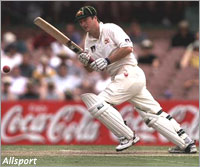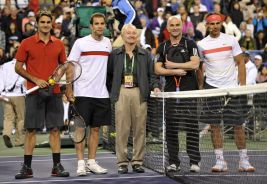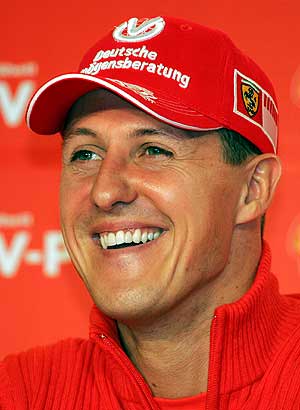Top 10 mentally tough sports giants
Sports stars whose mental abilities gave them the edge
Mental toughness is what gives sportsmen and women that extra few per cent required to truly excel at the top. Without mental strength, sports competitors are relying in their physical capabilities alone to see them through, which on their own are often not enough.
Sport has been filled with a host of winners who undoubtedly had mental strength in vast quantities. You just knew that no matter how much pressure they were put under, it would be very unlikely that they would crack – if anything, their body would be more likely to give out before their mind did.
Here’s realbuzz.com’s top 10 of those sporting giants who seemingly have or had that mental edge:
Bjorn Borg
 Borg at the age of seventeen with his female fans.
Borg at the age of seventeen with his female fans.
Unquestionably one of the coolest customers on the tennis court, so much so that the words ‘ice, cool, and Swede’ came to be associated with him. His calm court demeanor and unflappability earned him the nickname of the ‘Ice Man’ or ‘Ice-Borg’. The Swede never seemed flustered – unlike some of his main rivals such as Jimmy Connors or John McEnroe – and he has been the model on which many coaches have tried to get their protégés to follow. His winning of a fifth consecutive Wimbledon singles title in a five-set epic with John McEnroe came after the American had saved five match points in the fourth set. That would usually have been enough to break many.
Muhammad Ali

Can anyone in sport have ever displayed as much confidence as Muhammad Ali? Self titling himself ‘the greatest’, Ali was the best at talking himself up, and his psychological tactics before, during, and after fights are the stuff of legend. Ali talked as good a fight as he fought, and his victory in the ‘Rumble in Jungle’ in 1974 against George Foreman – when he largely retreated to the ropes and invited Foreman onto him while taunting him verbally – were aimed at exhausting Foreman mentally and physically. It worked, and Ali regained his World Heavyweight title when few had given him a chance.
Steve Waugh

There is no other way to describe Steve Waugh, other than one of the most obdurate mentally tough batsman cricket has ever seen. Waugh took himself from average cricketer to one of the best with a change of batting approach where he eliminated any flashiness, focusing purely on accumulating runs by punishing the bad balls. Waugh never seemed to be ruffled and put his success down to having an ability to focus solely on the next ball without a though to what had gone before. Anyone who witnessed his double century epic innings in 1995 against rip-roaring bowling assault from Curtly Ambrose and co knew they’d seen mental toughness of the highest order. Waugh’s Test match batting average of 51.06 says it all.
Pete Sampras

‘Pistol Pete’ had the uncanny knack of backing himself even in the most precarious of positions. With break points, set points and even match points against him, Sampras would go for broke and come up with a superb second serve that left his opponents dumbfounded. His mental focus allowed him to play his best at these decisive moments so that opponents often knew that an ace would be coming up – even on a second serve! Despite appearing rather dour on court and being accused of not showing any emotion, 14 Grand Slam titles are testament to Sampras’ toughness.
Michael Schumacher

German F1 driver Schumacher has always been viewed as a ‘win at all costs’ driver whose approach on the race track has drawn plenty of criticism. In both 1994 and 1997 he was involved in collisions, one of which gave him the title and another which cost him it. It was Schumi’s ability to produce fast laps and turn it on at crucial moments in a race that made his name. In races when the rain came, Schumacher’s opponents would crumble, with the German having the confidence to know that he was the best driver in the wet, and deserving of his name ‘the rainmaster’. Not satisfied with what he had achieved in his career, he returned to F1 in 2009.
Tiger Woods
 Tiger Woods is in the unenviable position of knowing that he’s the best and that most others just think they are competing for the runner up spot. Tiger has proven his mental superiority time and time again. Many questioned whether his focus would still be there when he got married. The same happened when kids came along, when his father died, and even when his marriage collapsed due to his infidelities, but each time he has bounced back and been as good as ever, if not better. Golf is a mental game and Tiger is the master. His victory in the US Open in 2008 when clearly struggling with a knee injury was clearly a case of mind over matter.
Tiger Woods is in the unenviable position of knowing that he’s the best and that most others just think they are competing for the runner up spot. Tiger has proven his mental superiority time and time again. Many questioned whether his focus would still be there when he got married. The same happened when kids came along, when his father died, and even when his marriage collapsed due to his infidelities, but each time he has bounced back and been as good as ever, if not better. Golf is a mental game and Tiger is the master. His victory in the US Open in 2008 when clearly struggling with a knee injury was clearly a case of mind over matter.

Niki Lauda

No sportsman has ever shown the same kind of toughness as F1 driver Niki Lauda, who given up for dead following an appalling accident, yet was back behind the racing wheel just weeks later. In what many commentators have described as the most courageous comeback in sporting history, the Austrian driver was pulled from the burning inferno that was his Ferrari at the Nurburgring in 1976. Suffering first to third degree burns on his head and wrists, several broken bones and lungs scorched from inhaling toxic fumes, he was actually given the last rites by a priest. Just six weeks and two races later, he returned and finished fourth in the Italian Grand Prix. He went on to win the F1 title in 1977, retired in 1979, and then returned three years later before going on to clinch his final world title in 1984.
Haile Gebrselassie

Has the world of athletics ever been graced with as wide a smile as Haile Gebrselassie’s? Win or lose, the Ethiopian takes it in his stride and continually confounds those who have written him off. From a 1993 World Championship gold on the track to setting a new marathon world record (2:03:59 in Berlin in 2008), Gebrselassie has allied his immense running talent with a will to win. To date he has broken well in excess of 20 world records and won numerous world and Olympic titles. His decision to return to the sport after announcing his retirement prematurely is testament to his will to win.
Lance Armstrong

Few sports can be more testing mentally than endurance cycling and Lance Armstrong has to be considered the best. Not only did he win the Tour De France seven times (1999-2005), but this came against the background of having survived testicular cancer which had spread to his brain and lungs in 1996 when he had been given only a 40 per cent chance of survival. As if that wasn’t enough, Amstrong had it in him to make a return to professional cycling after a three-year absence in order to raise awareness of cancer.
Don Bradman
The volume of runs scored on uncovered pitches against some of the best bowlers of the time at a Test career average of 99.94 pretty much says it all. Bradman’s career figures are considered statistically the greatest achievement in any sport. But his greatest achievement could arguably be the 396 runs (at an average of 56.57) for the series that he scored in the infamous Bodyline series. With a ruthless tactic, the English sought to counter Bradman’s brilliance by bowling leg-side short-pitched deliveries aimed to unnerve the batsman and consistently aim the ball at the batsman. Under such trying circumstances it was amazing that The Don was able to hold his nerve and produce such as series of great unorthodox shots to counter the English spoiling tactics.
















 cage measuring four feet tall and six feet wide, strung with nylon mesh in the back.
cage measuring four feet tall and six feet wide, strung with nylon mesh in the back.

